#Microdata
Explore tagged Tumblr posts
Text

UK 1982
9 notes
·
View notes
Text

MicroData Technologies Companion2000 Datapad (with Recording Rod)
Source: The Essential Guide to Weapons and Technology (Del Rey, 1997)
#star wars#general equipment#microdata#microdata technologies#companion2000#datapads#recording rod#essential guide to weapons and technology#essential guides#computers
8 notes
·
View notes
Text

the real MICROdata refinement
#severance#helly r#mark s#irving b#dylan g#mark scout#helena eagan#irving bailiff#macrodata refinement#gabuart#when i first posted my previous drawing i wrote microdata instead of macrodata and it was haunting me#i cant draw a lot these days bc im in my last uni trimester but please know im trying
212 notes
·
View notes
Text
of all the things to get Foiled By, 'the government took down that data so you can't do fanfic math with it any more' has got to be top 5 funniest
#my chaurts... please... my income distributions... my microdata...#i personally think it's beautiful that the government has historically enabled#gay sex fanfic writers to ensure the historical &economic accuracy of their fanfic#(among obviously Other Uses of that data.)#and you should too!#mine#writing tag
1 note
·
View note
Text
Isn’t it ironic that despite following mainly the innie’s stories throughout an entire two seasons- the ending had most people rooting against mark’s innie.
Despite establishing Ms Casey as a distant character from Innie mark- despite witnessing outie Mark’s outright dismissal of Helly as a person- people still want to hate innie Mark for grabbing at what very little power he could control in a world that just uses him as a tool.
Used for microdata refinement- used to save a wife that he has no connection to- and yet people get mad when he doesn’t want to go back to that powerlessness.
143 notes
·
View notes
Text

On the severed floor straight up refining “it” and by “it” well, let’s just say, my microdata
#severance#helly r#severance helly#severance fanart#fanart#disco elysium#sketchbook#artists on tumblr#illustration#digital art#sketch#LEBRON JAMES SCREAM IF YOU LOVE SEVERANCE#AHHHHHHHHHH#helly r the woman that you are
105 notes
·
View notes
Text

I GOT HER GUYS ILL POST MORE UPDATES LATER THEYRE ON MY TAIL
just pulled up. getting her outta there myself idgaf

8K notes
·
View notes
Text
the “dorner truck explosion” mentioned in The Lexington Letter (a companion short story for Severance) is also mentioned in The You You Are.
in The Lexington Letter, peg kincaid details her experience as a severed employee. peg and her innie, peggy k, begin to communicate using a made up language from peg’s youth. peggy k initiates the contact explaining that the language has been in her head for weeks. since the language is made of symbols rather than letters, the code detectors are seemingly unable to detect the notes. she eventually explains her decision to leave the company after connecting the dorner therapeutics truck explosion with her innie’s completion of the lexington file.

peg explains this weird connection to her innie, and their communication goes dark for some time. peggy k ends up telling peg to leave lumon after many shifts in the break room. with this final note, peg is given a microdata refinement orientation booklet.
in The You You Are, the dorner truck explosion is mentioned again.

this has got me wondering if we will be seeing a mention of this in the show itself, or if we may see a connection between microdata refinement and some type of corporate espionage?
#probably not since everyone is on side quests and not really refining#fun to think about nonetheless#the lexington letter#the you you are#severance#severance season 2#gimme the lore
89 notes
·
View notes
Text
if mark s. is so important for cold harbour (which is literally the gemma project) does that mean they're actually filtering the consciousness of people they know? like gemma is definitely dead in outer world but they're cloning and "refining" her data. microdata refinement could possibly deal with cloning of their loved dead one's memory or a dead person's in general and that is why those numbers are scary because it invokes a feeling of anxiety/grief. remember how mark has a record time in data processing maybe he was able to do that because his subconscious knew his wife so well. notice how the 5 boxes below are similar to kind of boxes they fill after filtering the numbers

#++ completing this project will probably give them insight on how to fully clone an innie which they can exploit 24/7 idk IDK#all of this could mean nothing#severance#severance spoilers#mark scout#severance s2
65 notes
·
View notes
Note
Y’all are so lost in your microdata it’s insane holy shit
It’s not a birthday cake there’s not someone making sure everyone’s getting equal shares that doesn’t mean it’s malicious christ
Now say the same thing about the gender pay gap. Or college admission rates prior to affirmative action. You see how fascist you sound when you apply that to any other minority group?
Yeah. I want you to think long and hard about how you anonymously told queer women that they're all wrong to complain about how little they are represented.
Btw, that's not what microdata is. If you're make up definitions for statistics terms, try not send that to a Stats major. Microdata, is defined as the individual subjects' data, and it is, in my opinion, the most useful of this data.
Let's talk about the most transfem representation we have ever gotten at one Persephone Valentine on The Sevn, and immediately after that year, it spiked back down to what it was before and continued to stagnate.
Let's talk about how transfems tend to have complicated relationships with drag given their storied history of transmisogyny, and how every fuck-up in my asks keeps acting like we should be happy because there are transfem drag queens on Dropout. Can you imagine how fucked it would be if the only people of color on the show were on Breaking News and nothing else? Why is it acceptable for the only consistent transfem rep being drag and the occasional Um Actually episode?
Love your little birthday cake metaphor btw, really disguising the fact that your argument is "equality bad".
And I never said it was malicious by Dropout. You can go ahead and spin whatever dumbfuck rhetoric you want, but don't lie, got it?
Go fuck yourself. Have a wonderful day.
#dropout#ask#dropout tv#monet x change#monet's slumber party#breaking news#um actually#persephone valentine
36 notes
·
View notes
Text
is anyone going to talk about the fucking MDR multiverse crew ??? severance: into the seververse ??? macrodata-refinement-refinement ??? microdata expansion ??? bizzaro!MDR ??? WHO ARE THOSE GUYS
37 notes
·
View notes
Text

PEOPLES POLICY PROJECT
Preface
Addressing Wealth Inequality
When discussing the inadequate and unequal structure of the economy, progressives tend to focus on things like poverty, income inequality, and wages. These are seen as the stuff of people’s everyday experience with the economy and as the areas that deserve our most pressing attention.
But the most unequal aspect of our economy is actually the way in which our national wealth is distributed. The top ten percent of American households own around three-fourths of the nation’s wealth while the bottom fifty percent owns virtually none of it. While the precise distribution of wealth has changed a bit over time, in the data that we have, the vast majority of the national wealth has always been in the hands of a relatively small slice of the population.
Most efforts to tackle wealth inequality focus on the national level. But states can and, in at least one case, have had a huge impact on the way that wealth is distributed among residents of the state. In this section, we look at wealth inequality in Washington and propose that Washington create an Alaska-style Permanent Fund aimed at gradually reducing wealth inequality in the state.


It is difficult to precisely estimate the level of wealth inequality in Washington state using public data sources.
The Federal Reserve’s Survey of Consumer Finances (scf), the nation’s preeminent wealth survey, only interviews 6,500 families across the entire country and does not reveal the states in which those families reside. The Census Bureau’s Survey of Income and Program Participation (sipp) interviews around 24,000 households across the entire country, but only around 700 in Washington state. The sipp also understates wealth levels at the top of the distribution through the use of topcoding and by failing to get survey participation from very wealthy households.

In order to overcome the limitations of these surveys, researchers are typically forced to make somewhat speculative adjustments that go beyond the survey microdata. For example, a recent WA report “hot decked” data from the American Community Survey (acs) with the Survey of Consumer Finances in order to overcome the scf’s low sample size and lack of residency information. This kind of hot decking works by assuming that acs and scf households that are similar in some respects—such as number of vehicles, home ownership status, and age—are also similar in other respects, such as wealth.
Hot decking allows the researchers to combine the big sample size and residency information of the acs with the wealth information of the scf, but the method basically amounts to assuming that WA’s wealth inequality is no different from wealth inequality in America as a whole. This is a reasonable assumption, but it also makes the whole exercise somewhat unnecessary. If WA’s wealth inequality more or less mirrors American wealth inequality, then one could achieve roughly the same insights by looking directly at the USwide scf data without the intermediate hot decking step.
In what follows, we take a somewhat different approach to overcoming the limitations of these wealth surveys. In our approach, we pool all of the responses from the four waves of the sipp survey that cover the years 2017, 2018, 2019, and 2020. Pooling these waves increases the WA sample size to around 2,400 households. As a proportion of WA households, this sample is 16 times the size of the scf sample as a proportion of US households. In the below graph, we compare the US wealth distribution in the 2019 scf to the US and WA wealth distributions in the pooled 2017–2020 sipp.
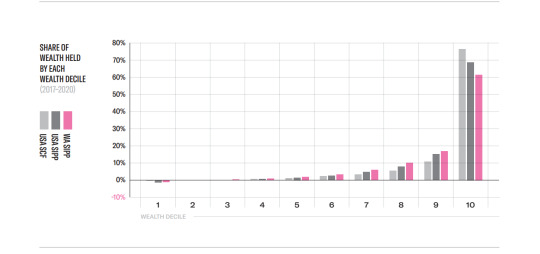
Overall, the three distributions look similar. In each, the bottom half of the distribution owns 1 to 2 percent of the wealth while the top half of the distribution owns 98 to 99 percent of the wealth. In the scf, the top 10 percent of US families hold 76 percent of the wealth while, in the sipp, the top 10 percent of US households hold 69 percent of the wealth and the top 10 percent of WA households hold 62 percent of the wealth.
This divergence is consistent with the fact that the sipp topcodes its wealth variables and does not get as much participation from very wealthy households as the scf does. The two figures may also differ because the scf family unit is not defined the same way that the sipp household unit is defined.
Here is another visualization of wealth inequality in WA using the sipp, graphed as a proportion plot.
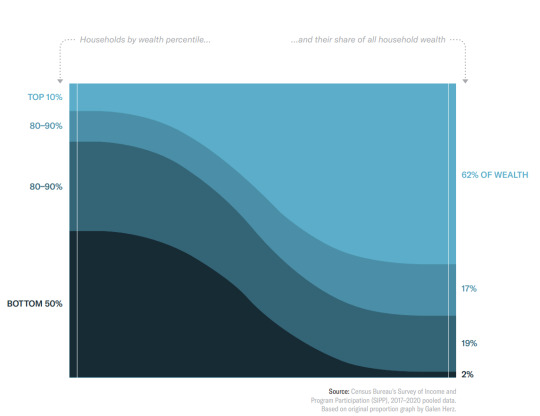
One way to partially overcome sipp’s limitations when it comes to reporting the information of the very wealthy is to add information from lists of the wealthiest Americans, such as the Forbes Billionaires List. Adding the Washingtonian billionaires included in the Forbes list increases the wealth share of the top 10 percent of WA households from 62 percent to 66 percent.

This modification helps bring the wealth distribution closer in line with reality, but the resulting distribution still likely understates the percentage of wealth held at the top. For the remaining analysis, we will only use the data contained in the pooled 2017–2020 sipp. Rather than try to partially correct for its understatement of top wealth by adding in a handful of billionaires or imputing higher wealth levels from the scf, we think it is clearer to simply note that the sipp has limitations when it comes to accurately reporting wealth at the top end of the distribution and to ask readers to incorporate that fact into their interpretation of the following sipp statistics.


The SCF assigns assets and liabilities to families not persons. So, for example, in the case of a married couple with two children that owns a home, the value of that home is assigned to the family as a whole, not to one or the other spouse or the children. The demographic characteristics of each family, and thus the demographic characteristics of the wealth they own, are derived from the information of the reference person in the household. So, if the reference person in the above homeowning family is a Black, college-educated, 35-yearold man, the value of the home ends up characterized as Black wealth, college-educated wealth, millennial wealth, and male wealth, even if other members of the family unit have different demographic characteristics.

Unlike the scf, the sipp assigns assets and liabilities to persons, with household wealth being the aggregate wealth of the persons of each household. When assets and liabilities are owned jointly by multiple people, as in a family, sipp assigns their values fractionally to each of the joint owners. Thus, in the example above, if the Black, college-educated, 35-year-old, male homeowner is married, half of the home’s value is assigned to him, while the other half is assigned to his spouse. This means that, if his spouse has a different race, age, educational background, or gender, those demographic characteristics will show up as owning half of the value of the home. Because wealth is almost always analyzed on the household or family level, person-level distributions of wealth are rarely reported, even by researchers who use the sipp data. But the person-level distribution is also interesting and so we will include that distribution alongside the household-level distribution in this analysis.
In the following graph, we can see the difference between the person-level, adult-level, and household-level distribution of wealth in WA state over this period.

The adult-level distribution is more unequal than the household-level distribution and the person-level distribution, which includes the wealth of children, is more unequal than adult-level distribution.
The table below shows the wealth level of these three distributions at various wealth percentiles.
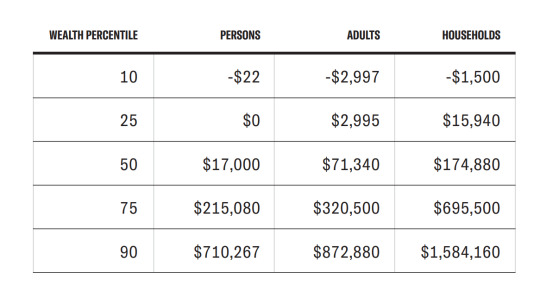
Across all persons, including children, the median wealth is $17,000. Across adults, the median wealth is $71,340. Across households, the median wealth is $174,880.
Race And Class
When comparing differences in wealth across race, it is common to look at the gap between mean and median wealth. The following table sums up these gaps for the person-level, adult-level, and household-level distribution in Washington.

On all measures, Black and Latino people have far less wealth than White people have. However, because White people are far more numerous in Washington than Black or Latino people are, the bottom of the wealth distribution still primarily consists of White people. This is true whether looking at the person-level, adult-level, or household-level distributions.
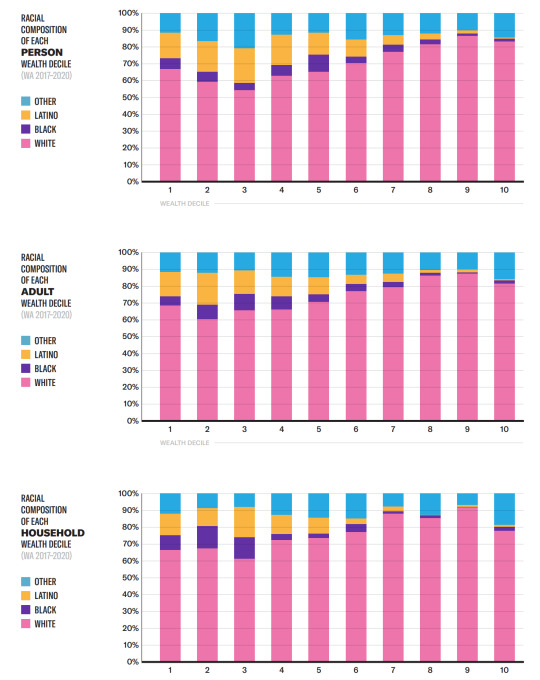

(Continue Reading)
#politics#the left#progressive#progressive movement#democratic socialism#socialism#peoples policy project#economics
26 notes
·
View notes
Text
microdata refinement team in the outdoors finding fucked up animals and experiencing woo woo shit in the wilderness... welcome back lost <3
21 notes
·
View notes
Text
Gonna make this a quick one since I just don’t have the spoons for a really big effort post: Pre-CCP 20th Century China Did Not Have Feudal or Slave-like Land Tenancy Systems
Obviously what counts as “slave-like” is going to be subjective, but I think it's common, for *ahem* reasons, for people to believe that in the 1930’s Chinese agriculture was dominated by massive-scale, absentee landlords who held the large majority of peasant workers in a virtual chokehold and dictated all terms of labor.
That is not how Chinese land ownership & agricultural systems worked. I am going to pull from Chinese Agriculture in the 1930s: Investigations into John Lossing Buck’s Rediscovered ‘Land Utilization in China’ Microdata, which is some of the best ground-level data you can get on how land use functioned, in practice, in China during the "Nanjing Decade" before WW2 ruins all data collection. It looks at a series of north-central provinces, which gives you the money table of this:
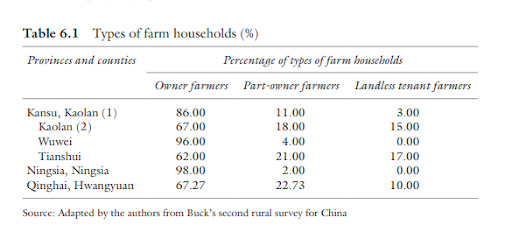
On average, 4/5ths of Chinese peasants owned land, and primarily farmed land that they owned. Tenancy was, by huge margins, the minority practice. I really don’t need to say more than this, but I'm going to because there is a deeper point I want to make. And it's fair to say that while this is representative of Northern China, Southern China did have higher tenancy rates - not crazy higher, but higher.
So let's look at those part-owner farmers; sounds bad right? Like they own part of their land, but it's not enough? Well, sometimes, but sometimes not:
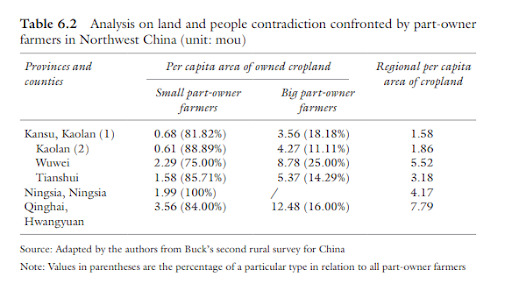
A huge class (about ~1/3rd) of those part-owners were farming too much land, not too little; they were enterprising households renting land to expand their businesses. They would often engage in diversified production, like cash crops on the rented land and staple crops on their owned land. Many of them would actually leave some of their owned land fallow, because it wasn’t worth the time to farm!
Meanwhile the small part-owners and the landless tenant farmers would rent out land to earn a living…sometimes. Because that wasn’t the only way to make a living - trades existed. From our data, if you are a small part-owner, you got a substantial chunk of your income from non-farm labor; if you owned no land you got the majority of your income from non-farm labor:
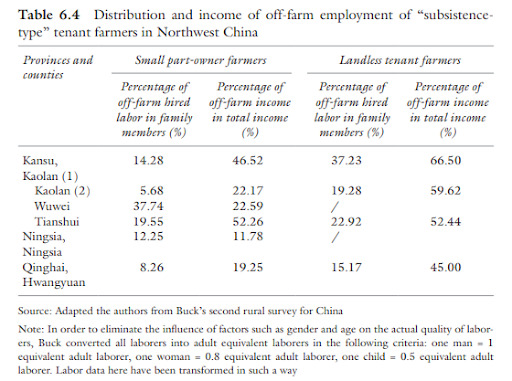
(Notice how that includes child labor by default, welcome to pre-modernism!)
So the amount of people actually doing full-tenancy agriculture for a living is…pretty small, less than 10% for sure. But what did it look like for those who do? The tenancy rates can be pretty steep - 50/50 splits were very common. But that is deceiving actually; this would be called “share rent”, but other systems, such as cash rents, bulk crop rents, long-term leases with combined payment structures, etc, also existed and were plentiful - and most of those had lower rent rates. However, share rent did two things; one, it hedged against risk; in the case of a crop failure you weren't out anything as the tenant, a form of insurance. And two, it implied reciprocal obligations - the land owner was providing the seed, normally the tools as well, and other inputs like fertilizer.
Whether someone chose one type of tenancy agreement or the other was based on balancing their own labor availability, other wage opportunities, the type of crop being grown, and so on. From the data we have, negotiations were common around these types of agreements; a lot of land that was share rent one year would be cash rent another, because the tenants and market conditions shifted to encourage one or the other form.
I’m doing a little trick here, by throwing all these things at you. Remember the point at the top? “Was this system like slavery?” What defines slavery? To me, its a lack of options - that is the bedrock of a slave system. Labor that you are compelled by law to do, with no claim on the output of that work. And as I hit you with eight tiers of land ownership and tenancy agreements and multi-source household incomes, as you see that the median person renting out land to a tenant farmer was himself a farmer as a profession and by no means some noble in the city, what I hope becomes apparent is that the Chinese agricultural system was a fully liquid market based on choice and expected returns. By no means am I saying that it was a nice way to live; it was an awful way to live. But nowhere in this system was state coercion the bedrock of the labor system. China’s agricultural system was in fact one of the most free, commercial, and contract-based systems on the planet in the pre-modern era, that was a big source of why China as a society was so wealthy. It was a massive, moving market of opportunities for wages, loans, land ownership, tenancy agreements, haggled contracts, everyone trying in their own way to make the living that they could.
It's a system that left many poor, and to be clear injustices, robberies, corruption, oh for sure were legion. Particularly during the Warlord Era mass armies might just sweep in and confiscate all your hard currency and fresh crops. But, even ignoring that the whole ‘poverty’ thing is 90% tech level and there was no amount of redistribution that was going to improve that very much, what is more important is that the pre-modern world was *not* equally bad in all places. The American South was also pretty poor, but richer than China in the 19th century. And being a slave in the American South was WAY worse than being a peasant in China during times of peace - because Confederate society built systems to remove choice, to short-circuit the ebb and flow of the open system to enshrine their elite ‘permanently’ at the top. If you lived in feudal Russia it was a good deal worse, with huge amounts of your yearly labor compelled by the state onto estates held by those who owned them unimpeachably by virtue of their birthright (though you were a good deal richer just due to basic agriculture productivity & population density, bit of a tradeoff there).
If you simply throw around the word “slavery” to describe every pre-modern agricultural system because it was poor and shitty, that back-doors a massive amount of apologia for past social systems that were actively worse than the benchmarks of the time. Which is something the CCP did; their diagnosis of China’s problem for the rural poor of needing massive land redistribution was wrong! It was just wrong, it was not the issue they were having. It was not why rural China was often poor and miserable. It could help, sure, I myself would support some compensated land redistribution in the post-war era as a welfare idea for a fiscally-strapped state. But that was gonna do 1% of the heavy lifting here in making the rural poor's lives better. And I don’t think we should continue to the job of spreading the CCP's propaganda for them.
There ya go @chiefaccelerator, who alas I was not permitted to compel via state force into writing this for me, you Qing Dynasty lazy peasant.
290 notes
·
View notes
Text
I see we're all extremely normal about Gemma this morning.
Quick question though does her innie remember all the rooms? Like all of them? Because it would be extremely fucked if her memory was split between all the rooms, and THAT'S what the refiners are for.
Anyway when they find out what the microdata is for I don't think Mark is going to be finishing that file. He's going to file something else if you know what I mean. 👀
#severance#mark scout#gemma scout#also casey??? they named her casey on purpose#lumon named her that because she's just a case file to them#theres no way thats her maiden name.#if Mark doesn't file a law suit Gemma definitely will.#spoilers#severance spoilers
17 notes
·
View notes
Text
Choppy/Unrefined (haha) Severence theory (spoiler warning!):
I’ve seen a lot of theories floating around? A lot of them about cloning and stuff- but after reading a bunch of them, and after the most recent episode I think I have a theory about what Lumon is trying to achieve
I know it’s not a new theory, but my speculation is: Lumon is attempting to try and do one of those ‘mass mind controls’. It sounds a bit cheesy but there’s a lot of evidence ranging from Jame Eagan telling Helly that soon, everyone will become severed- resulting in everyone being ‘one of Kier’s children’. And with the whole severed floor having their own religious figure (Kier), and even scriptures and paintings- it feels like they’re trying to enforce an entirely ‘new world belief’ onto people who have already severed, and who are thus fresh to the world without prior interaction with the outside.
There is still a lot that is unanswered, but I do think that their aim is to eradicate a lot of human emotion, or at least rebellious attitudes so that individuals can become compliant, to only believe Kier propaganda, but even preach it (to the extent that Cobel does).
As we can see with Gemma- she’s subjected to various different rooms that can correlate each with the four tempers: Woe, Frolic, Dread and Malice- like dread being associated with writing many thank you notes in the Christmas room. However it could also be the fact that rather than each room representing one of Kier’s four tempers- each room tests how much tempers are present when subjected to each each room, thus causing the microdata refinement workers to remove any of those tempers from a severed mind (to make individuals more compliant in stressful, rebel-causing situations).
(Note: compliance is also taught to other severed workers, including the microdata refinement squad by having them recite the apology until they believe it).
This could also be why there are goats- in order to bring about some sort of a ‘new world’ with animals they can have control over (which is a stretch but for a new world- you need a livestock or food source).
By severing Gemma so much- it would be easier to focus on which tempers to control in those various situations (i.e. controlling the tempers to reduce screaming, fear, and even disgust towards the food Gemma was served), so that it would be easier to reduce humanism in severed people, which Ms Huang reiterates a lot to Mr. Milchick, and what Helena tells Helly: that the workers are not ‘people’.
Although this doesn’t explain everything, like the symbolism of the water droplet most likely being blood- and a lot more minor details, that’s as much as I’m willing to theorize for now!
#severance#severance spoilers#severance theory#severance theories#severance s1#severance s2#gemma casey#gemma scout#helly r#helena eagan#kier eagan#mark scout
19 notes
·
View notes